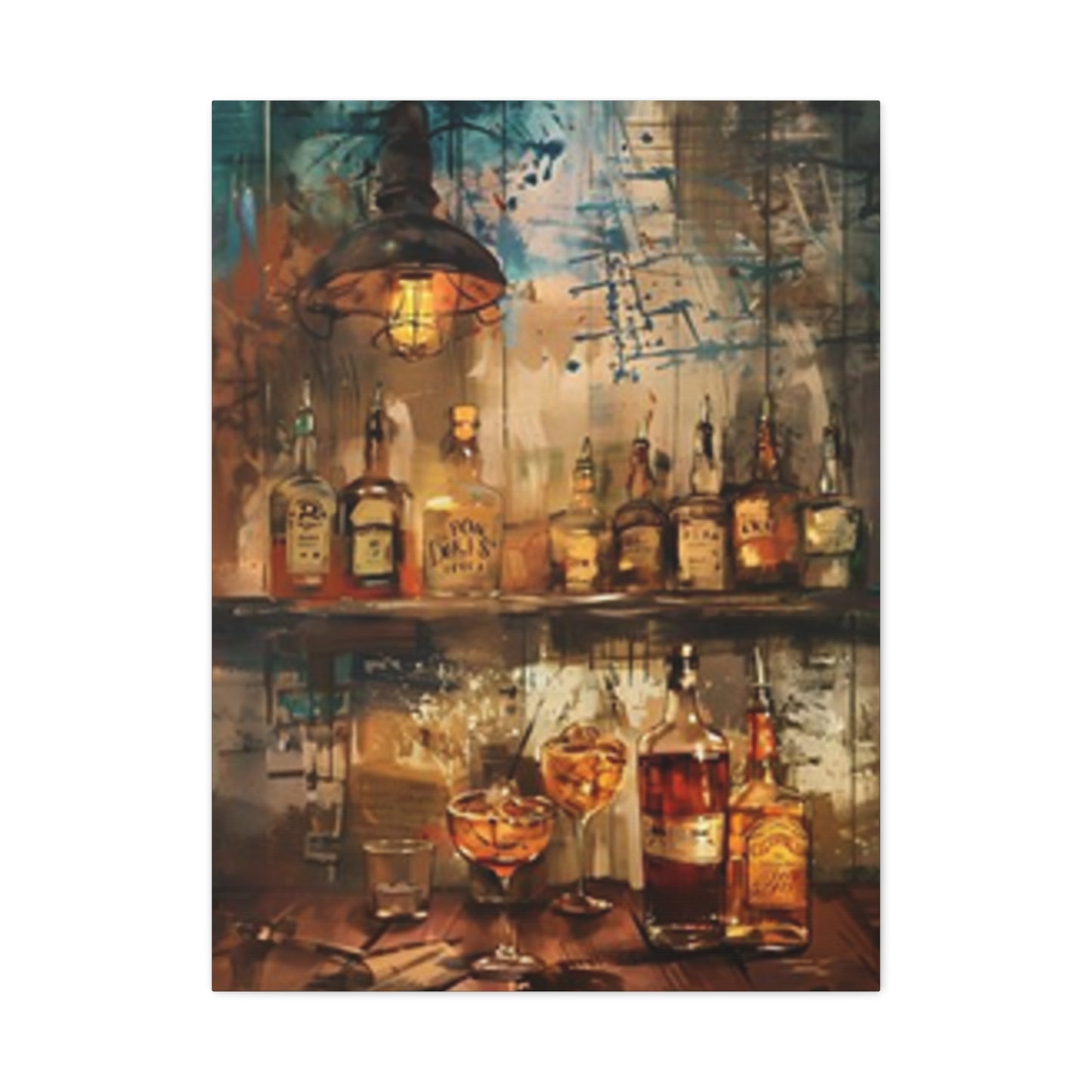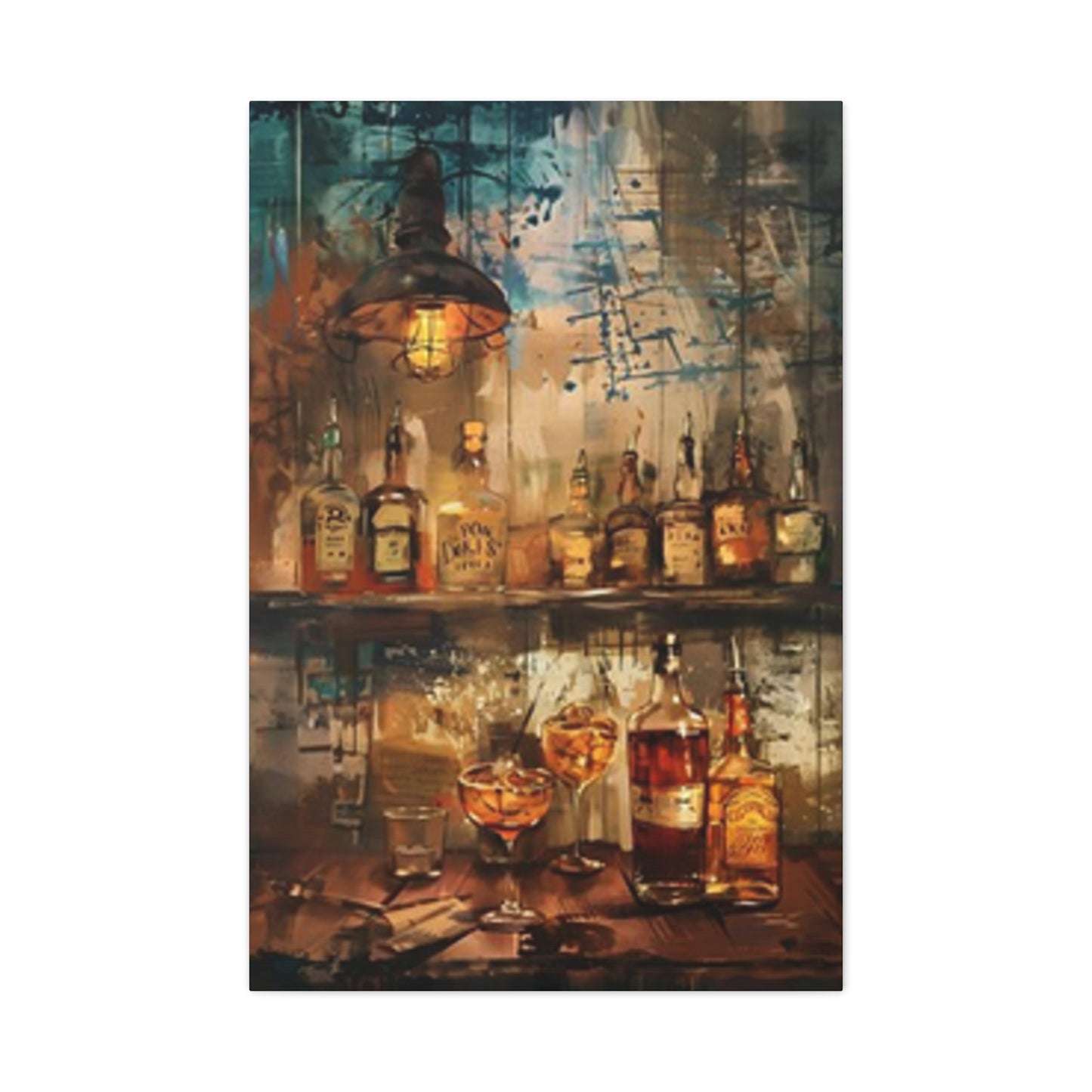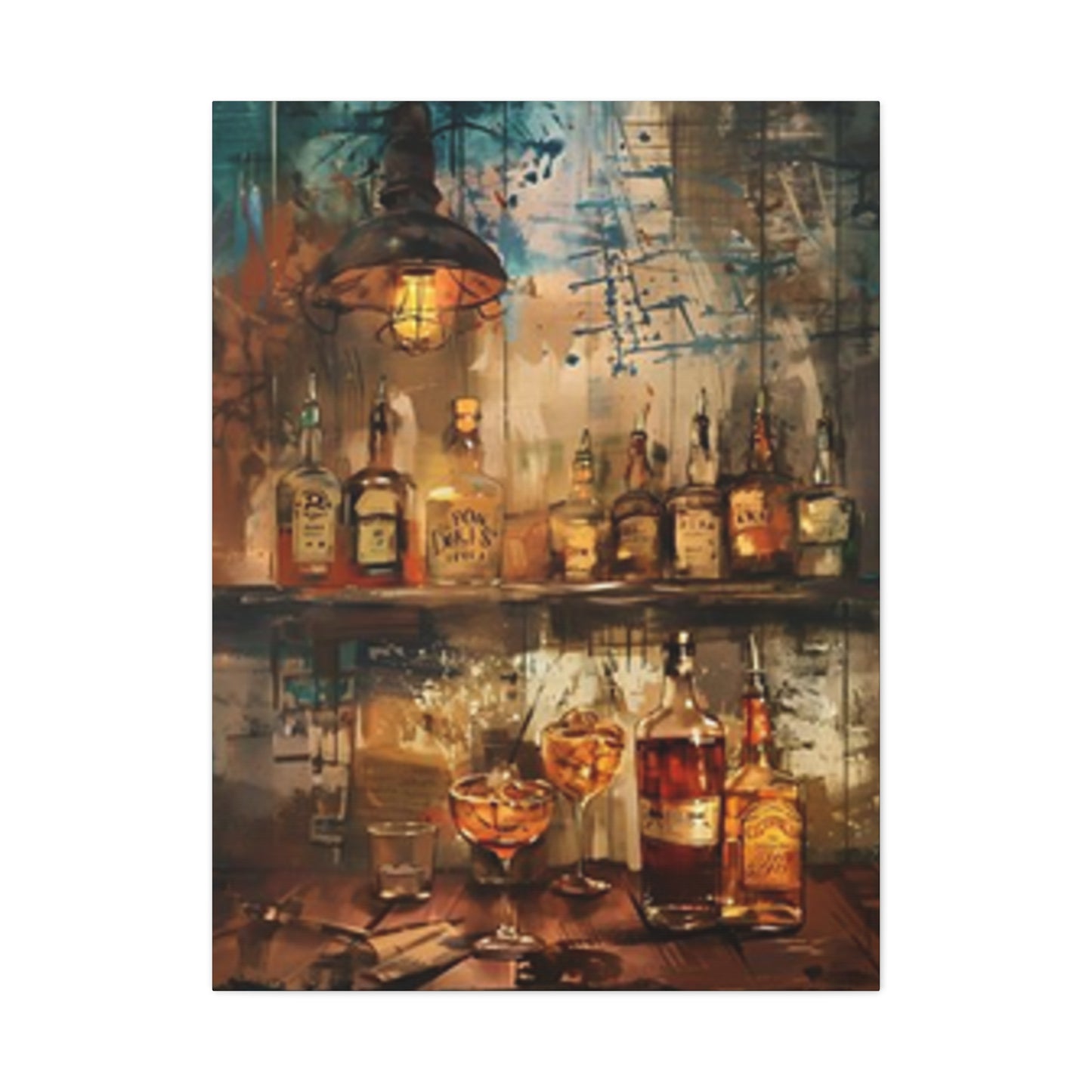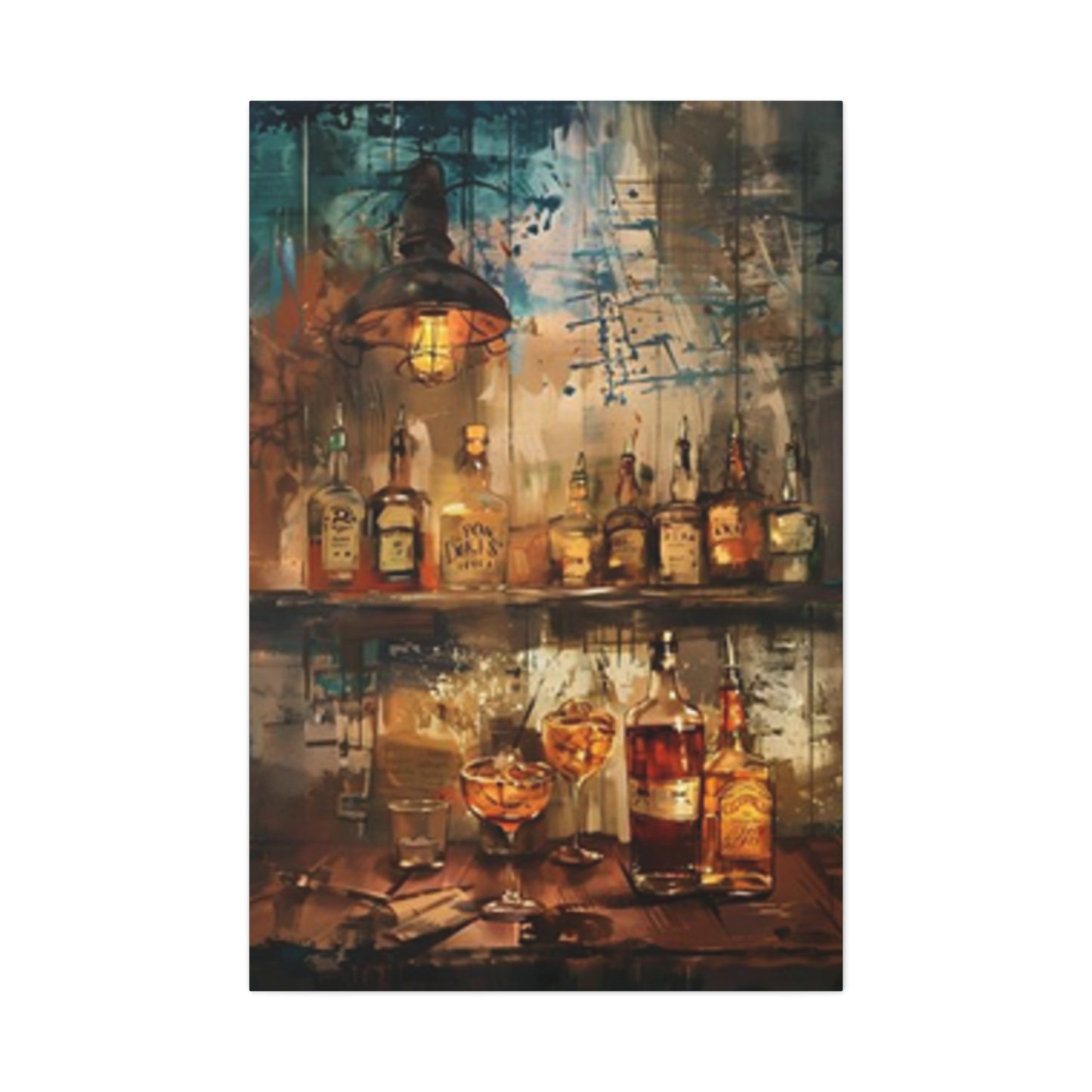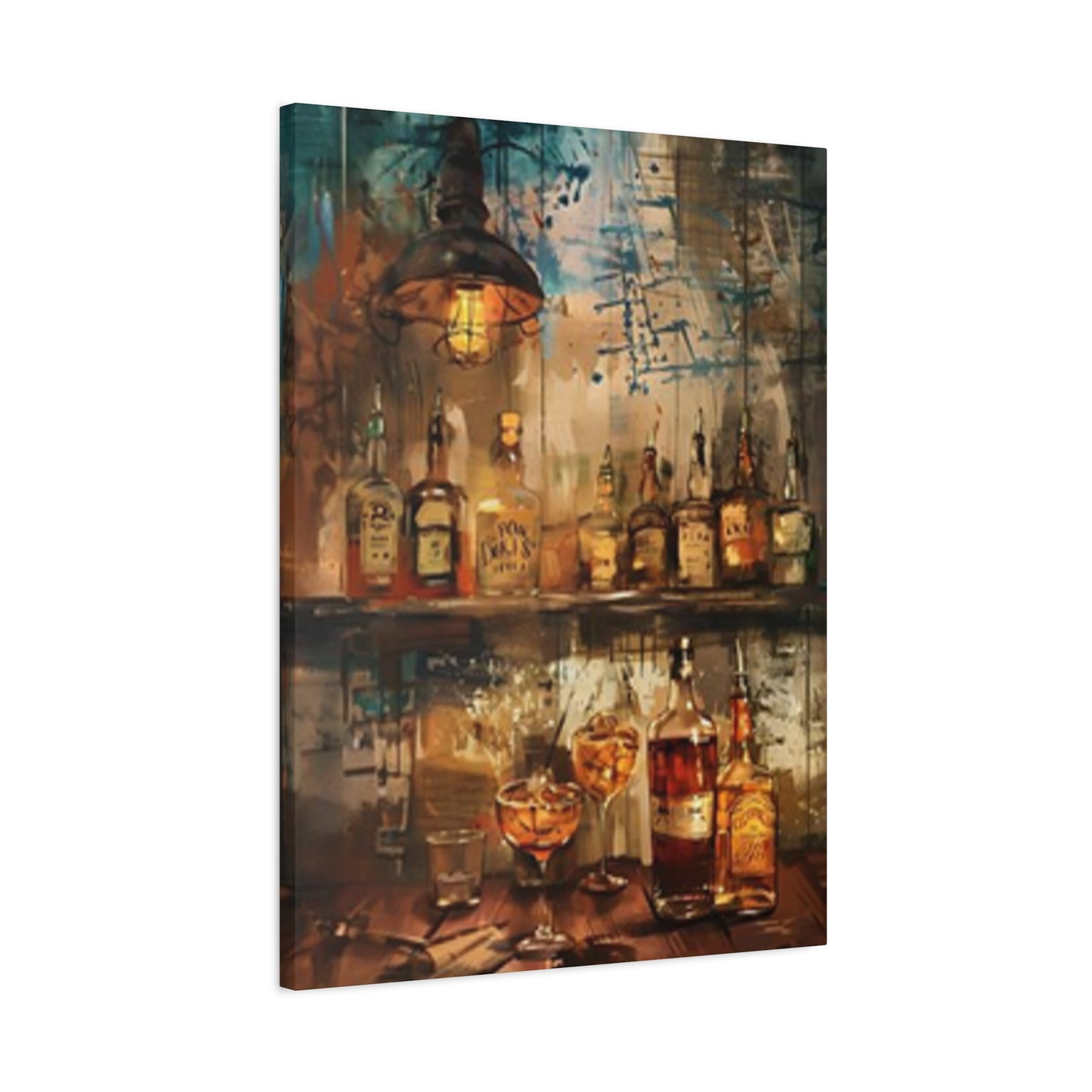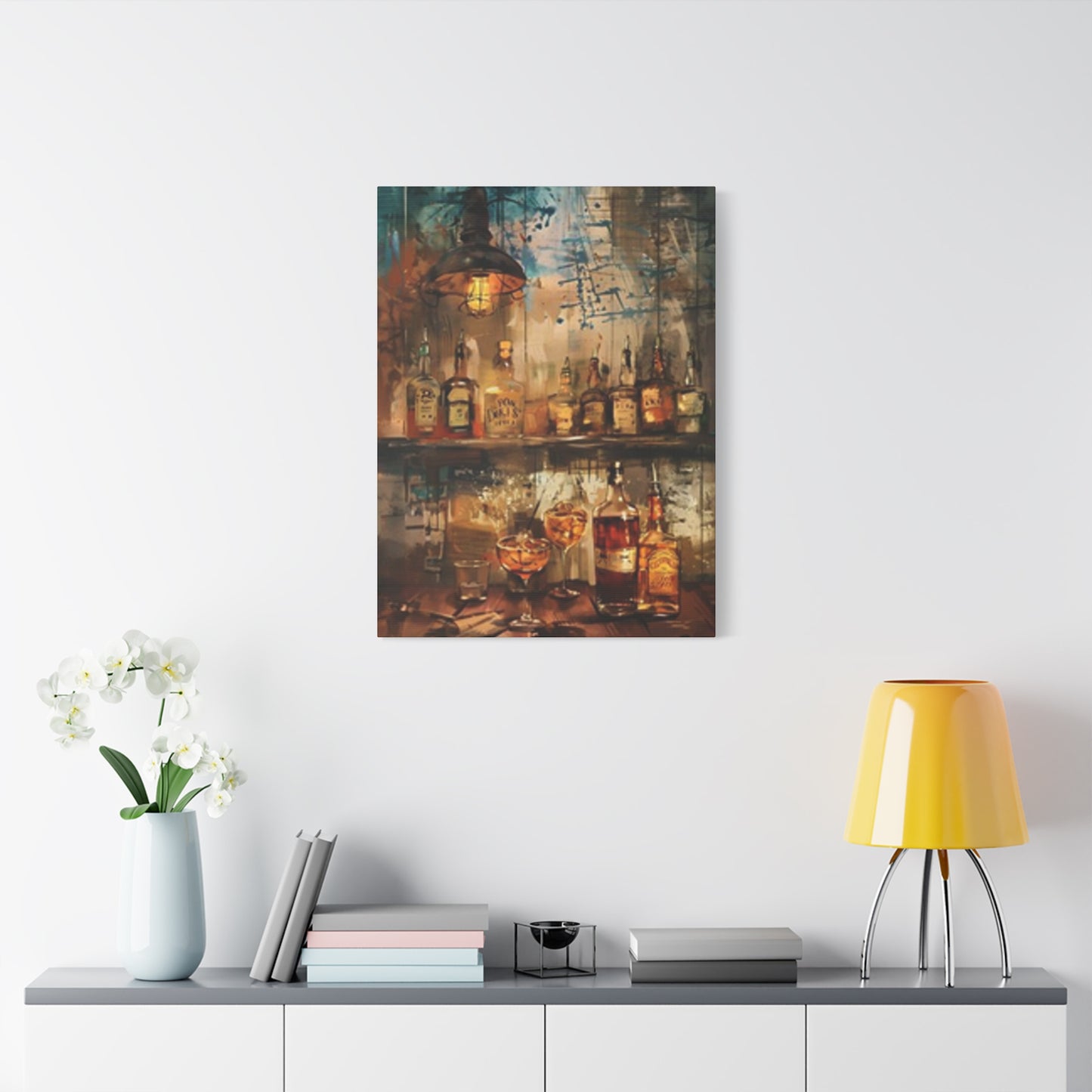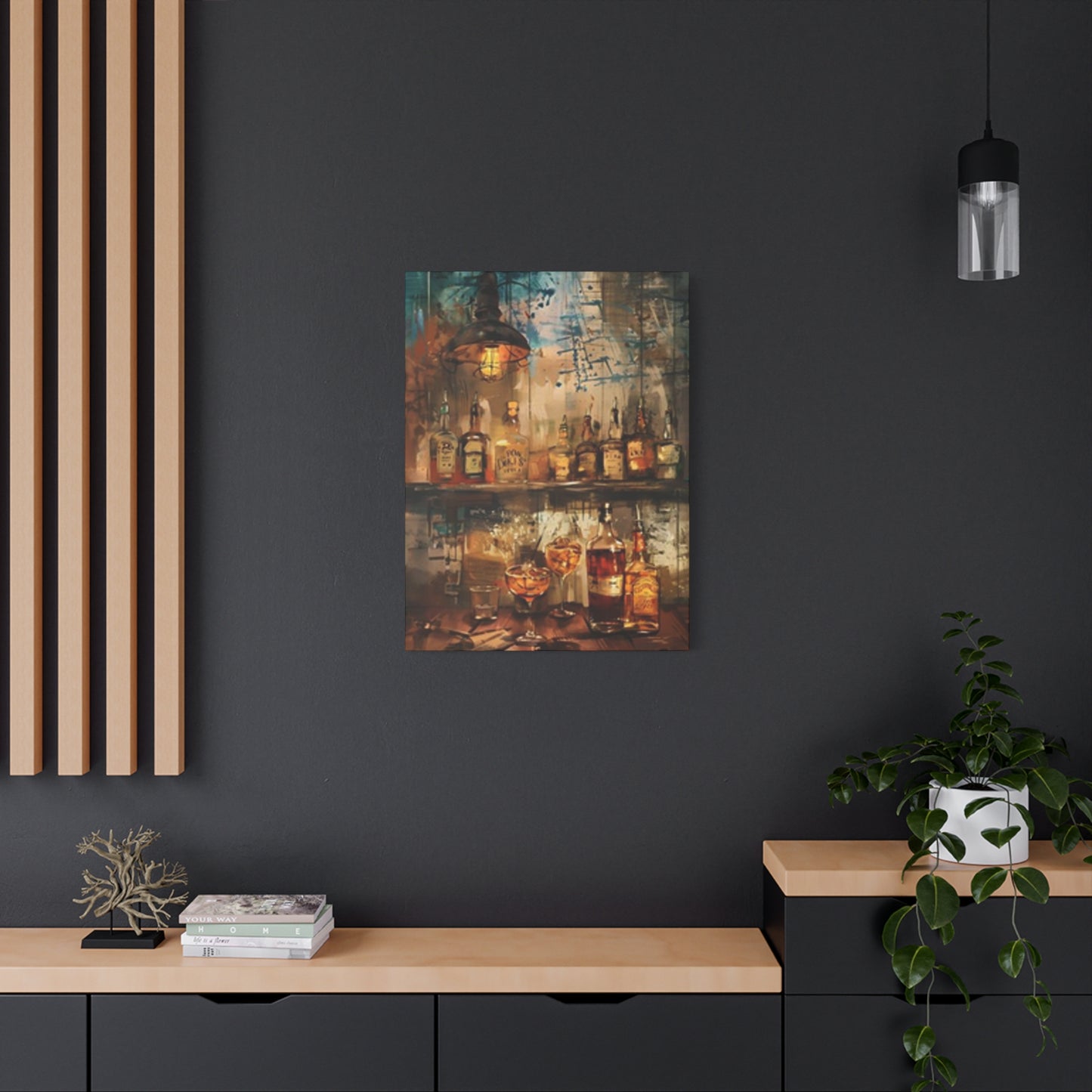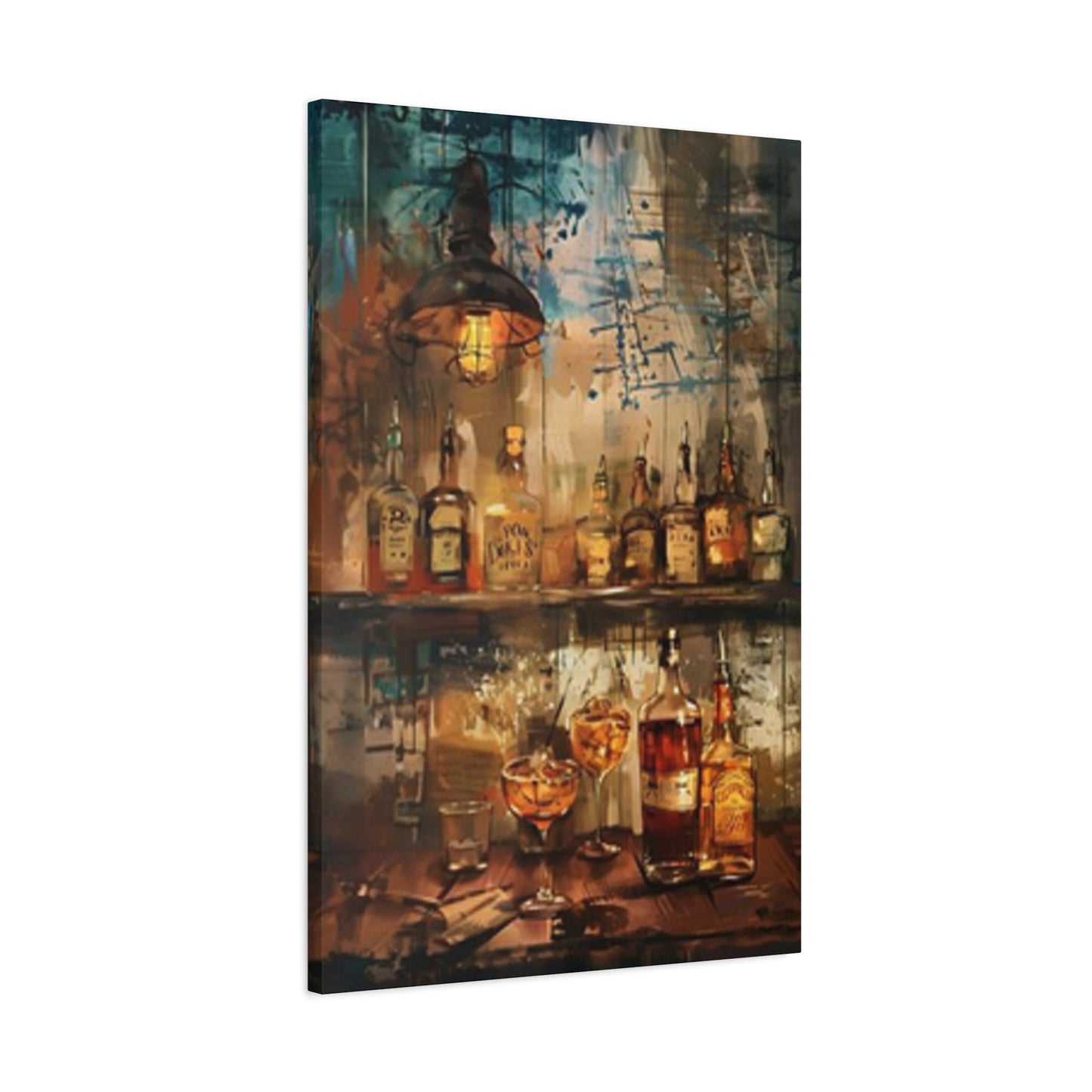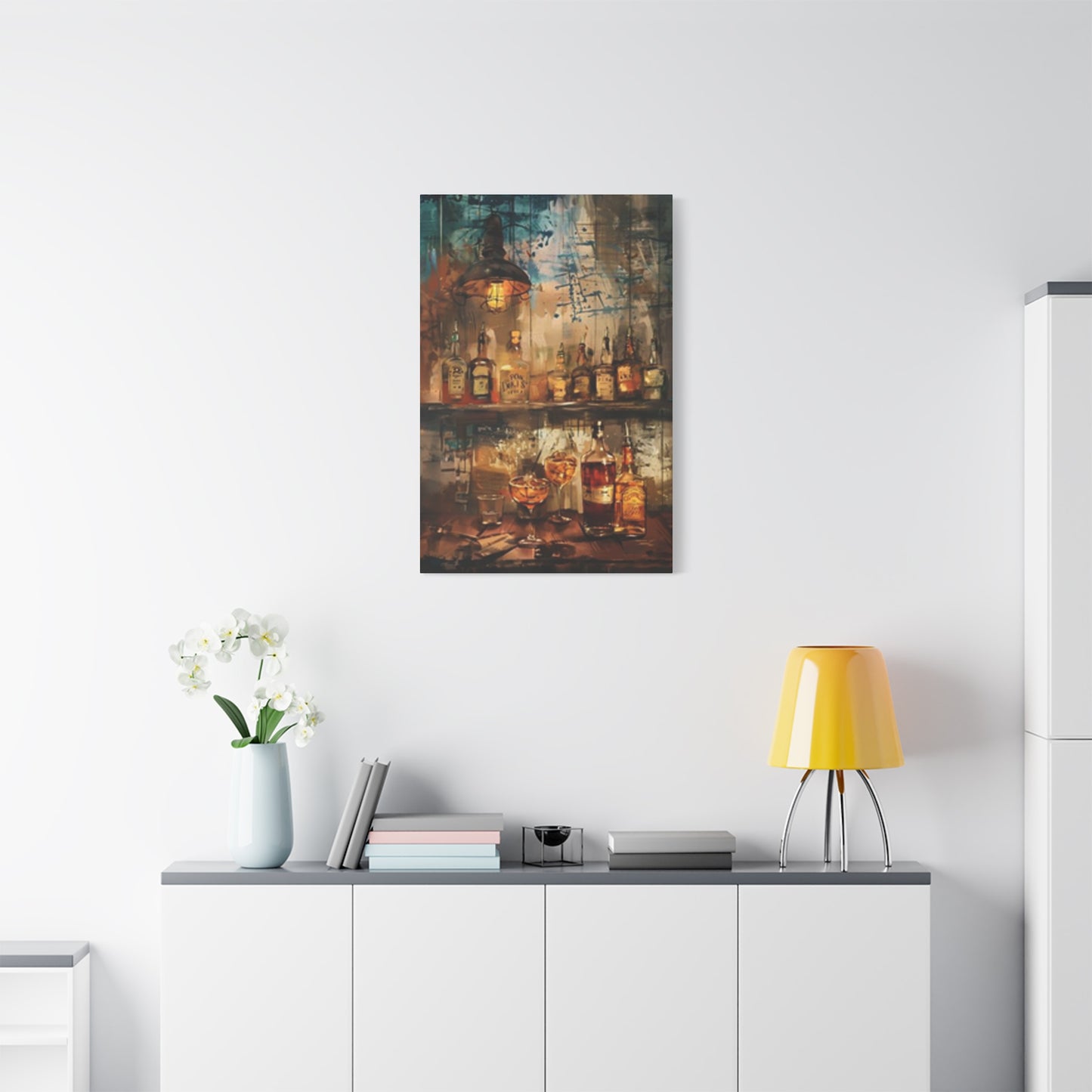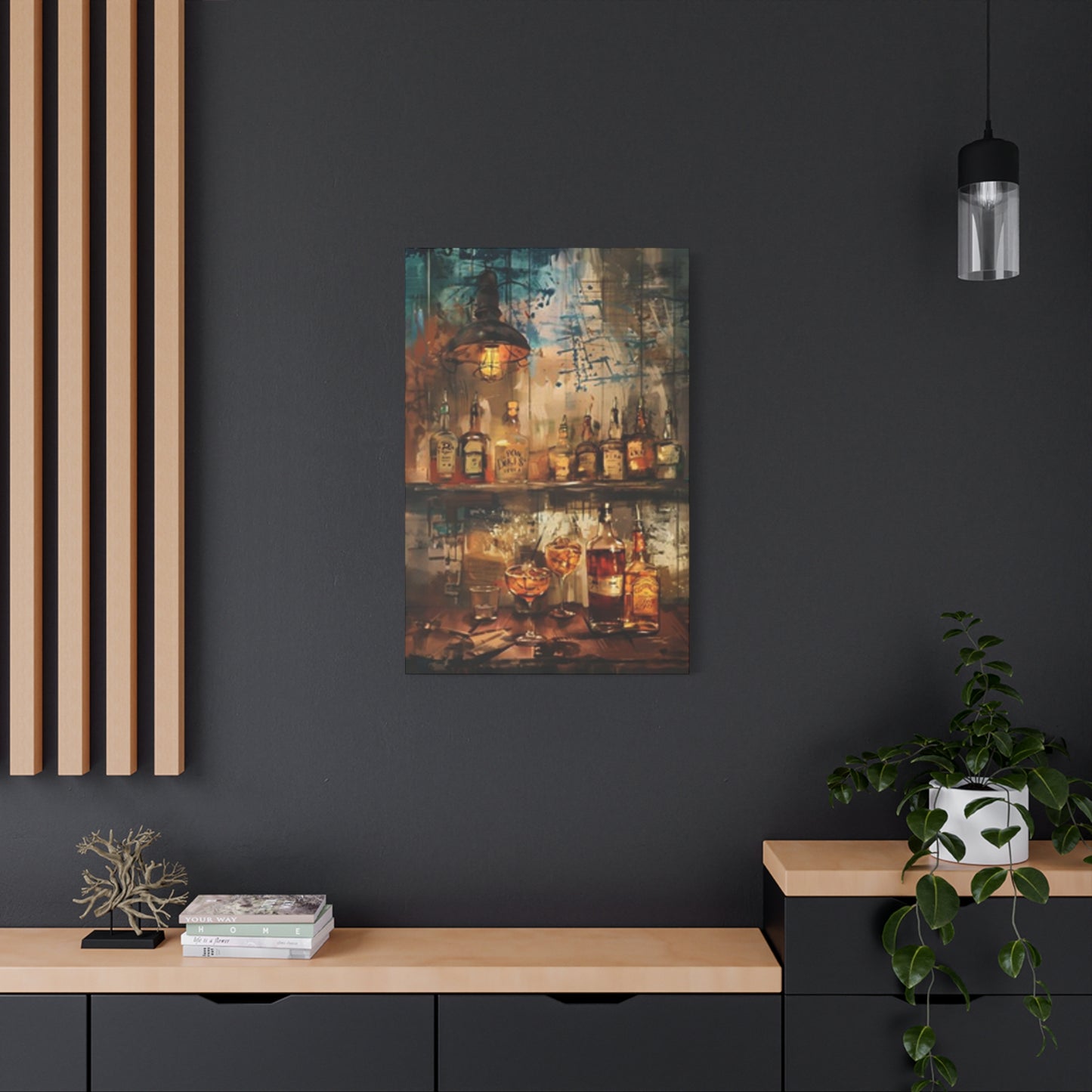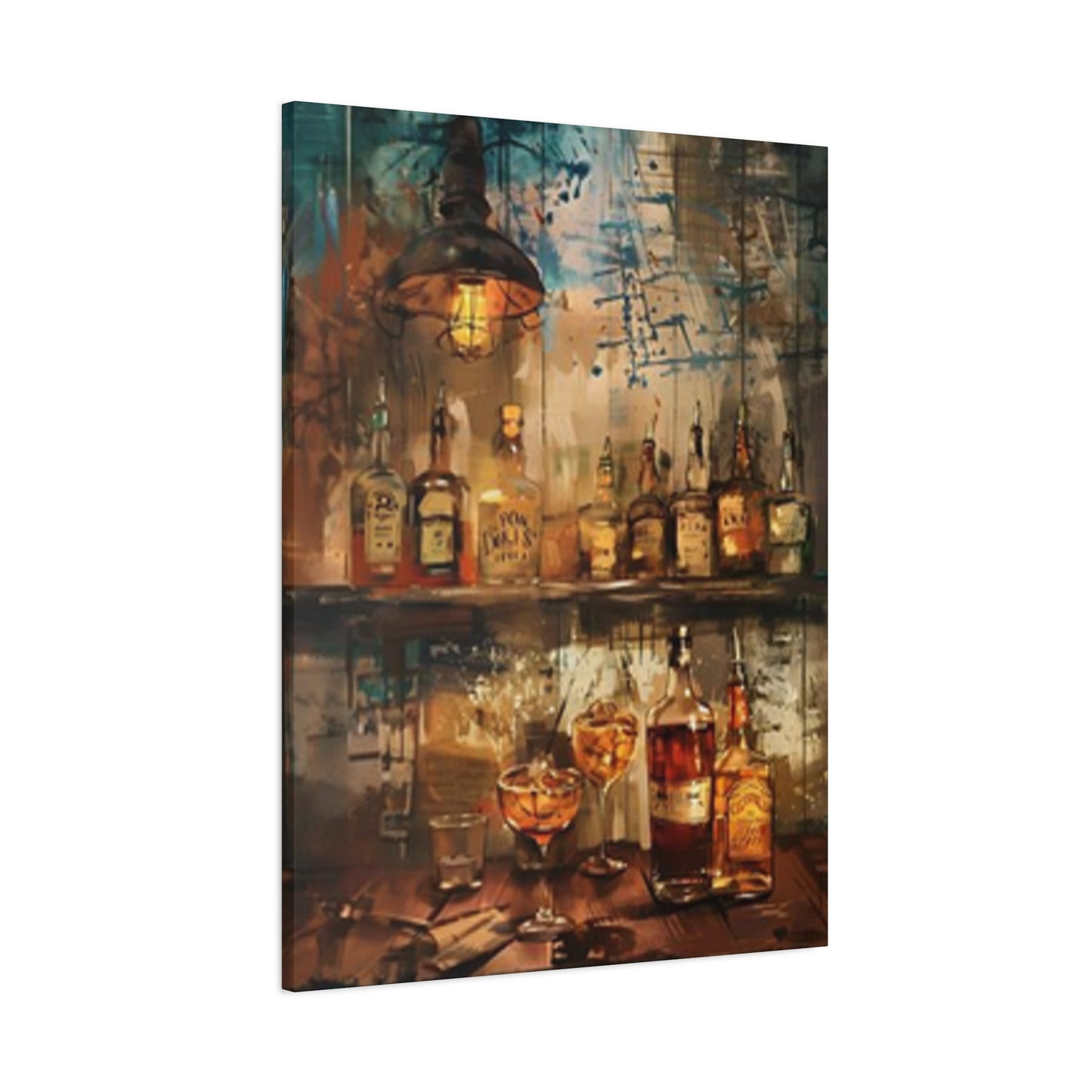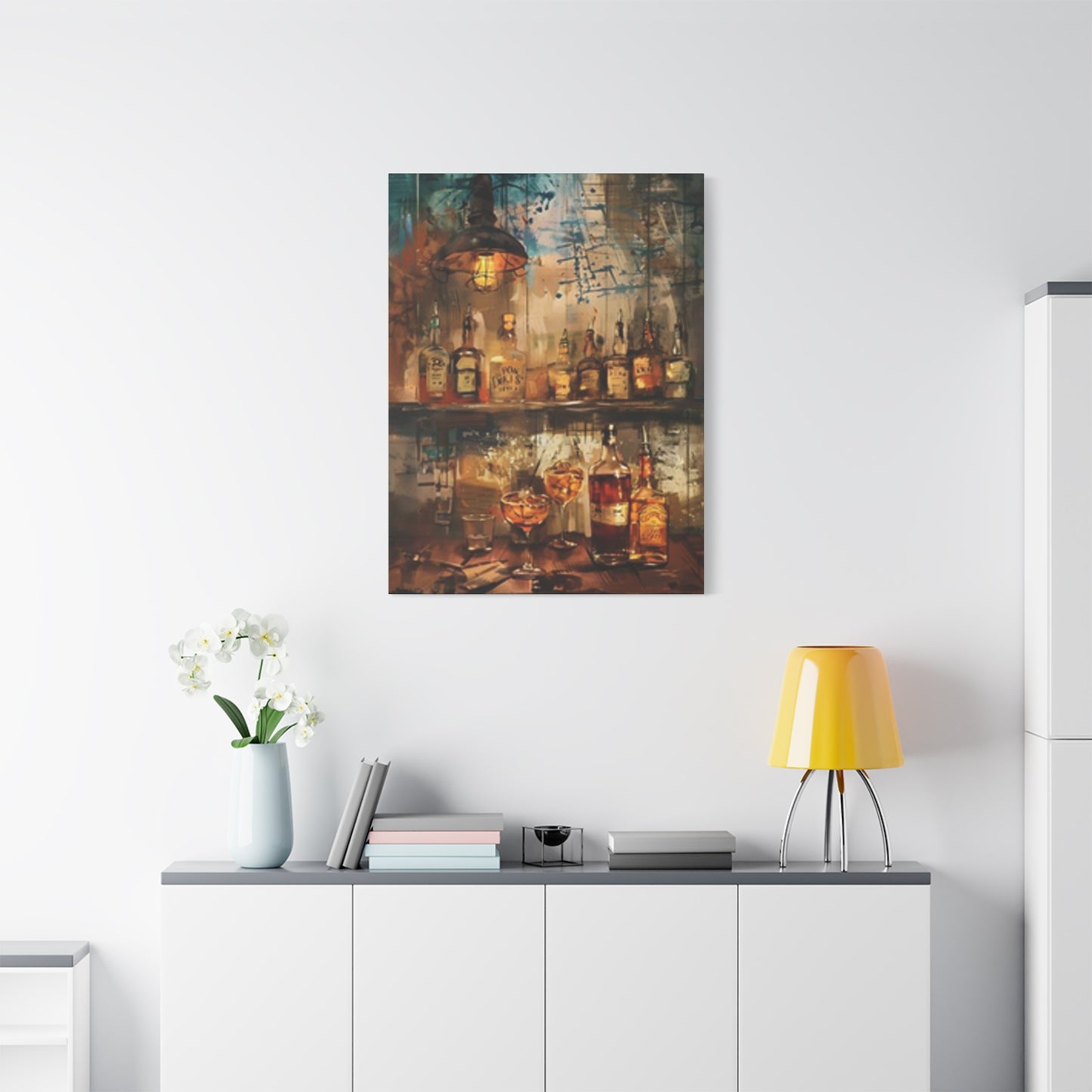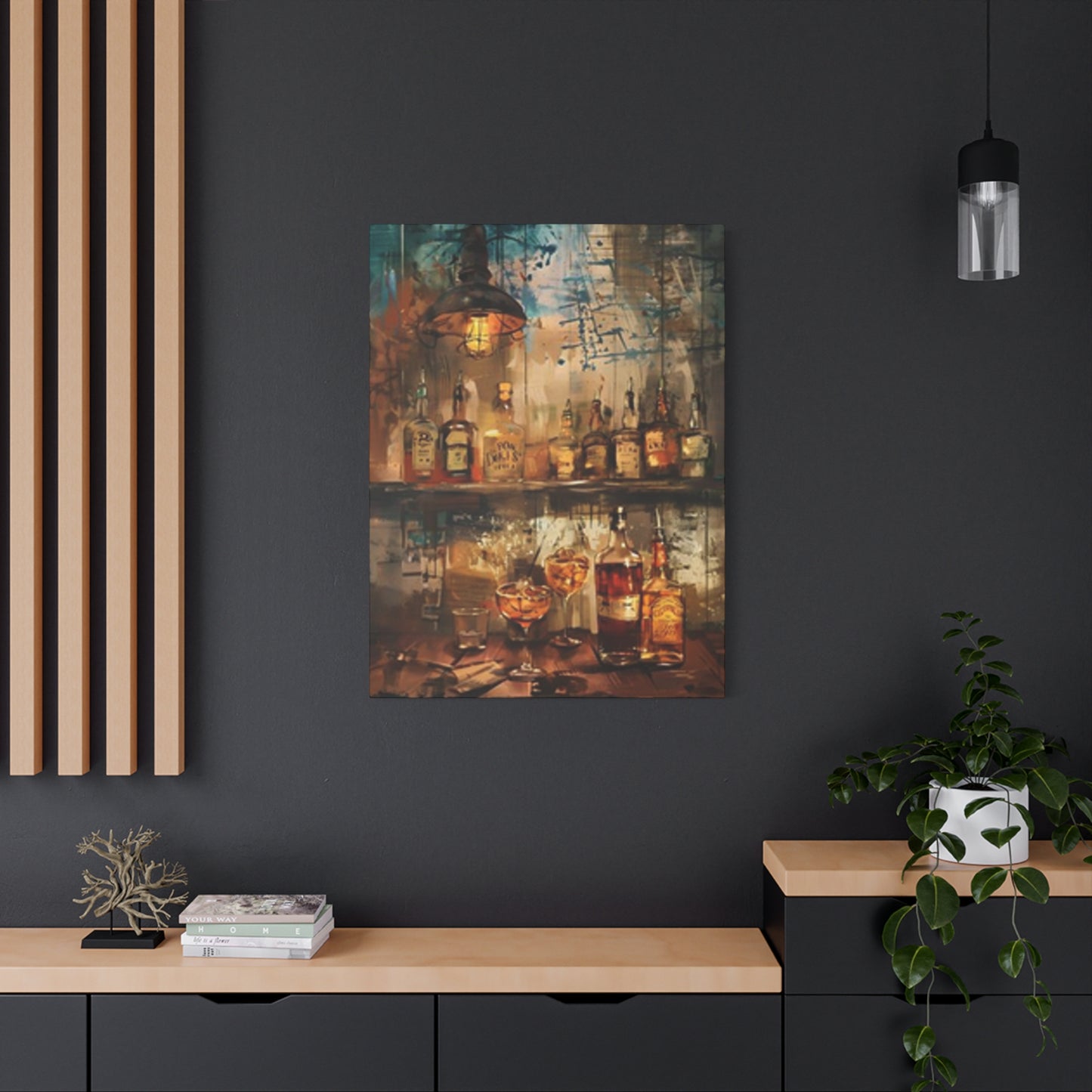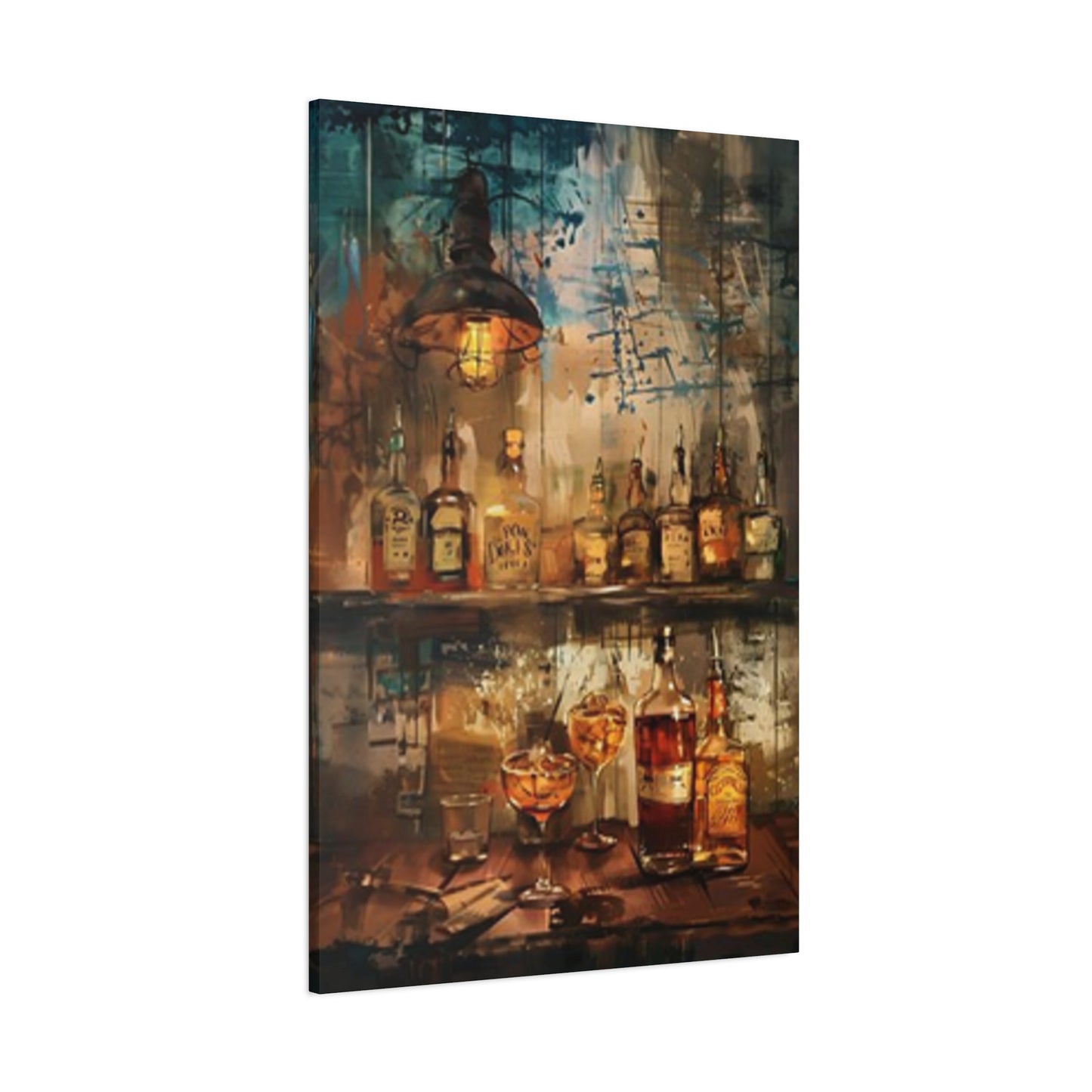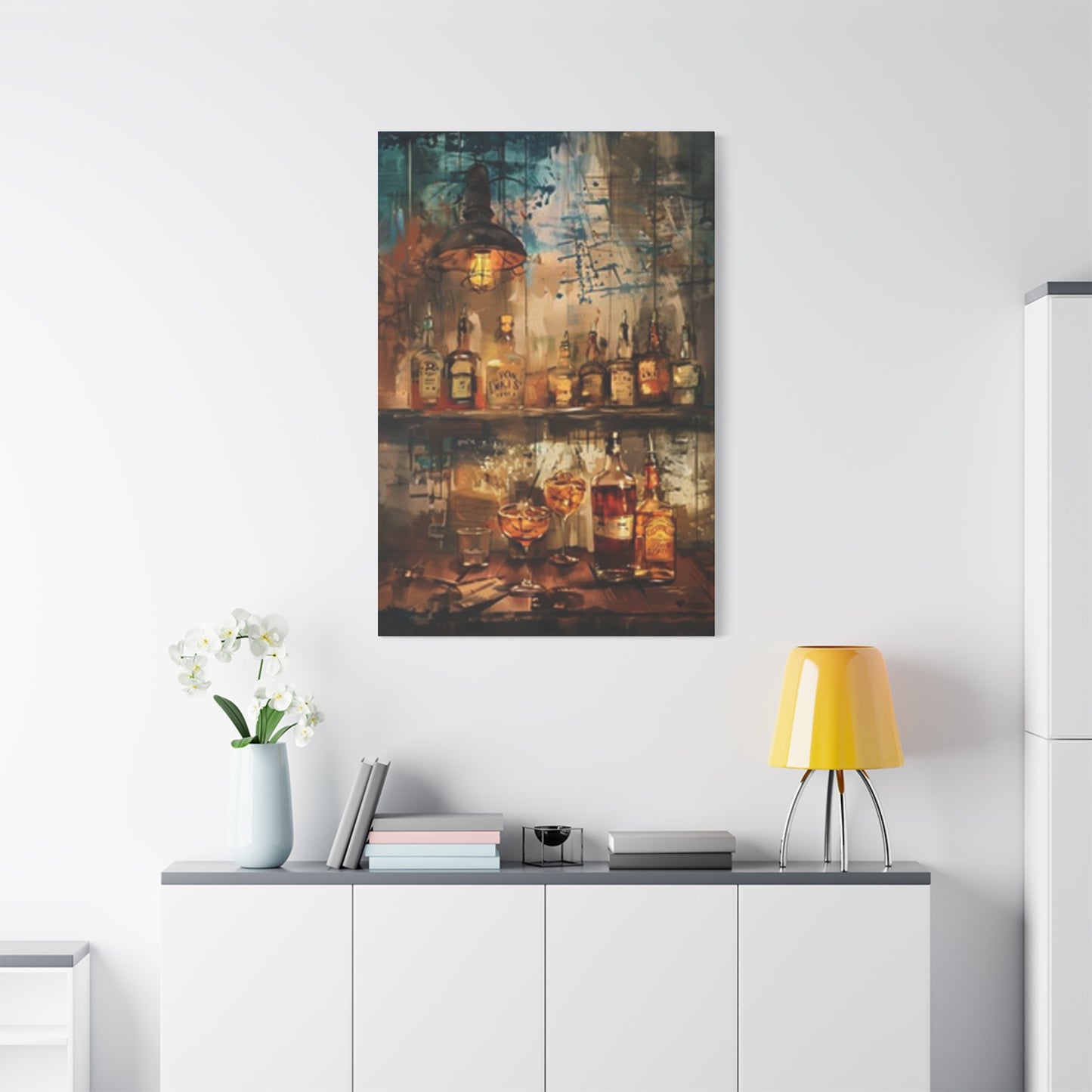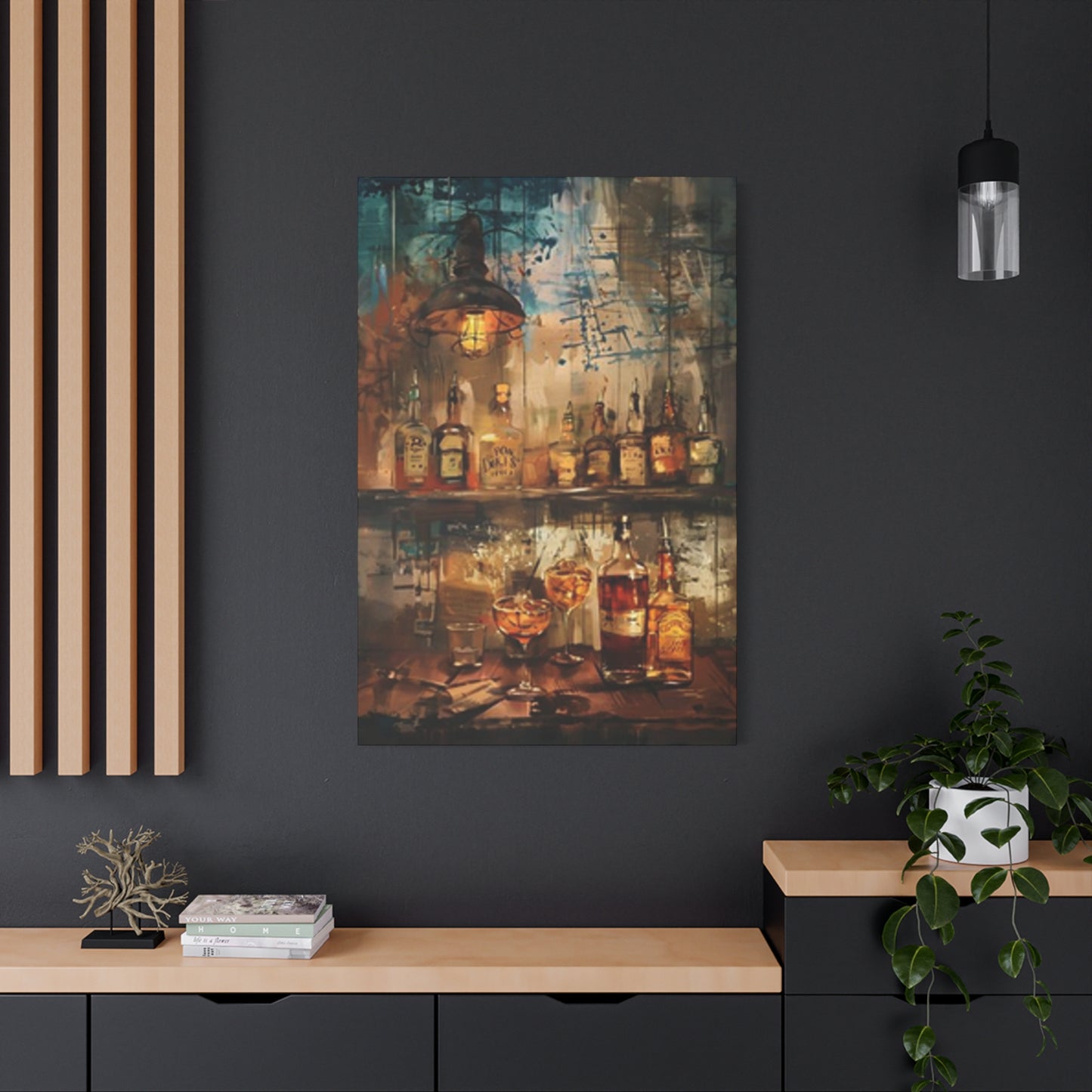Vintage Old Whiskey Bar Wall Art: Elevate Your Space with Nostalgic Charm
The allure of aged spirits and the ambiance of traditional drinking establishments have captivated enthusiasts for generations. When you combine this timeless appeal with artistic expression, you create something truly remarkable for interior spaces. Decorative pieces featuring historic tavern scenes offer a sophisticated way to infuse personality and character into any room while paying homage to the rich heritage of distilled spirits culture.
These artistic representations transport viewers to an era when oak barrels lined dimly lit establishments, bartenders carefully measured pours, and conversations flowed as smoothly as the amber liquid in crystal glasses. Whether adorning a personal entertainment area, home office, or residential lounge space, these decorative elements create an atmosphere of refinement and nostalgia that resonates with those who appreciate the finer aspects of beverage culture.
Antique Tavern Artwork for Interior Spaces
The popularity of vintage drinking establishment themed decorations has surged among homeowners seeking to create distinctive atmospheres within their living spaces. These pieces capture moments frozen in time, depicting scenarios that evoke the golden age of American taverns and European pubs. From bartenders polishing glassware to patrons engaged in animated discussion, each piece tells a story that transcends mere decoration.
When selecting artwork featuring historic bar scenes, consider pieces that showcase authentic details from various eras. Images depicting prohibition-era speakeasies bring an element of mystery and rebellion, while representations of 1950s cocktail lounges evoke sophistication and glamour. Victorian-era pub scenes introduce ornate details and rich color palettes that add depth to any wall display.
The materials used in creating these decorative pieces significantly impact their overall aesthetic appeal. Canvas prints offer texture and depth that photographs cannot replicate, while framed prints behind glass provide a polished, gallery-quality appearance. Metal prints bring an industrial edge that complements modern interpretations of vintage themes, creating interesting contrasts between old and new design elements.
Placement considerations play a crucial role in maximizing the impact of these artistic pieces. Install them at eye level in areas where they can be properly appreciated, such as above seating arrangements, behind home bars, or along hallway corridors. Proper lighting enhances the visual experience, with strategically placed accent lights highlighting details and creating dramatic shadows that add dimension to the artwork.
The color schemes prevalent in historic tavern artwork typically feature warm earth tones, rich browns, deep ambers, and golden hues that mirror the appearance of aged spirits themselves. These palettes create welcoming environments that encourage relaxation and conversation, making them ideal for entertainment spaces where guests gather to socialize and unwind.
Authenticity matters when selecting pieces that truly capture the essence of traditional drinking establishments. Look for artwork that includes period-appropriate details such as vintage bottle labels, classic glassware styles, antique bar equipment, and historically accurate architectural elements. These details separate generic bar art from pieces that genuinely reflect the culture and atmosphere of bygone eras.
Size considerations affect how artwork integrates into existing decor schemes. Large statement pieces serve as focal points that command attention and anchor entire rooms, while smaller complementary pieces work well in groupings or gallery walls. Consider the scale of your space and furniture when determining appropriate dimensions for maximum visual impact.
Recreating Historic Drinking Establishment Ambiance in Residential Settings
Transforming personal spaces to reflect the atmosphere of traditional taverns requires thoughtful selection of decorative elements that work harmoniously together. Artwork featuring vintage bar scenes serves as the foundation for creating these immersive environments, but surrounding elements must complement the visual narrative established by the wall displays.
The textures and materials used throughout the space should echo those depicted in the artwork. Exposed brick or wood paneling provides authentic backdrops that enhance the vintage aesthetic. Dark wood furniture pieces with leather upholstery create seating arrangements reminiscent of classic bar stools and booth seating found in historic establishments.
Lighting fixtures play an essential role in establishing the proper mood. Edison bulb chandeliers, brass sconces, and pendant lights with amber-tinted glass shades cast warm glows that replicate the gaslight and early electric illumination that would have lit original taverns. Dimmer switches allow for adjustable ambiance suitable for different occasions and times of day.
Accessory items scattered throughout the space reinforce the theme established by the wall art. Vintage barware including cocktail shakers, mixing glasses, and decanters displayed on open shelving create functional decorative elements. Antique advertising signs, old bottles, and period-appropriate memorabilia add layers of visual interest that make spaces feel curated rather than decorated.
Flooring choices contribute to the overall authenticity of the environment. Wide-plank hardwood floors with distressed finishes evoke the worn surfaces of century-old establishments, while patterned area rugs add warmth and define conversation areas. Consider the patina and weathered appearance that develops naturally over time in authentic venues when selecting flooring materials.
Window treatments should maintain the balance between privacy and natural light while supporting the vintage aesthetic. Heavy drapes in rich fabrics like velvet or brocade create dramatic frames for windows, while wooden shutters or blinds offer more casual alternatives that still maintain period appropriateness. The goal is controlling light levels to maintain the intimate atmosphere characteristic of traditional drinking establishments.
Architectural details such as crown molding, wainscoting, and coffered ceilings add dimensional interest that complements the scenes depicted in the wall art. These elements create visual connections between the artwork and the physical space, making the transition between the two-dimensional images and three-dimensional environment feel seamless and intentional.
Color coordination throughout the space ensures cohesive design that feels purposeful rather than accidental. Pull accent colors from the artwork to use in throw pillows, upholstery, window treatments, and decorative accessories. This technique creates visual harmony that ties all elements together into a unified design scheme.
Enduring Tavern Imagery on Stretched Fabric
Canvas printing technology has revolutionized how we display and enjoy artistic representations of historic drinking establishments. This medium offers distinct advantages that make it particularly well-suited for depicting vintage bar scenes with depth, texture, and visual impact that captures the essence of these atmospheric spaces.
The fabric texture of canvas adds dimension to images that flat paper prints cannot achieve. This textured surface interacts with light in ways that create subtle shadows and highlights throughout the image, giving scenes greater depth and realism. When depicting dimly lit bar interiors, this quality becomes especially valuable as it enhances the play of light and shadow that defines these atmospheric spaces.
Gallery-wrapped canvas, where the printed image continues around the edges of the frame, creates a modern presentation that eliminates the need for traditional framing. This approach works particularly well for contemporary spaces where clean lines and minimalist aesthetics prevail, allowing the vintage imagery to stand as a bold contrast against sleek surroundings.
The durability of canvas prints makes them practical choices for spaces that experience temperature fluctuations or humidity variations, such as basement entertainment rooms or outdoor covered patios. Quality canvas prints resist fading, cracking, and warping better than paper-based alternatives, ensuring that the investment maintains its visual appeal for years of enjoyment.
Size flexibility represents another advantage of canvas printing for vintage bar artwork. Because the printing process scales effectively, you can commission custom sizes that fit specific wall dimensions perfectly, ensuring optimal visual impact without awkward gaps or cramped placement. This customization capability allows for creating statement pieces that truly command attention.
Multiple panel canvas installations, known as triptychs or polyptychs, offer dynamic ways to display expansive bar scenes across several connected pieces. This segmented approach creates visual interest through the negative space between panels while allowing for larger overall displays than single-piece installations. The technique works especially well for panoramic views of historic tavern interiors.
The depth of stretched canvas creates subtle three-dimensional effects that make artwork appear to float slightly away from the wall surface. This separation creates shadow lines that add to the overall visual impact and helps the piece stand out from its surroundings rather than blending flatly against the wall.
Coating options for canvas prints affect both appearance and longevity. Matte finishes reduce glare and provide subtle, sophisticated presentations that work well in spaces with multiple light sources. Glossy finishes enhance color vibrancy and create dramatic visual impact, though they require more careful placement to avoid problematic reflections.
Sophisticated Wall Decorations for Spirit Aficionados
Enthusiasts of aged spirits seek decorative elements that reflect their passion for quality beverages and the culture surrounding them. Artwork depicting historic drinking establishments provides refined options that celebrate this interest without resorting to clichéd or juvenile representations often associated with bar decor.
Scenes featuring oak barrel storage rooms capture the aging process that transforms raw distillate into complex, nuanced spirits worthy of contemplation. These images appeal to those who appreciate the craftsmanship and patience required to produce exceptional bottles. The geometric patterns created by stacked barrels and the rich color gradients of aging cellars create visually compelling compositions.
Representations of historic distilleries and their tasting rooms offer educational dimensions alongside aesthetic appeal. These pieces often include architectural details, equipment, and processes that tell stories about production methods and heritage. For serious enthusiasts, such artwork serves as conversation starters and opportunities to share knowledge with guests.
Portrait-style pieces featuring bartenders, distillers, or notable figures from spirits history add human elements to collections. These character studies capture personalities and tell stories about individuals who shaped beverage culture. Placing these portraits alongside scene-based artwork creates varied gallery walls with multiple focal points.
Still life compositions featuring bottles, glasses, and related accessories offer more subtle approaches to the theme. These arrangements can range from simple, minimalist presentations to complex, layered compositions with dramatic lighting and rich symbolism. The versatility of still life artwork makes it suitable for spaces where overt bar theming might feel inappropriate.
Abstract interpretations of bar scenes and spirits culture provide contemporary alternatives for those seeking modern artistic expressions of traditional themes. These pieces maintain thematic connections while offering bold colors, unusual compositions, and innovative techniques that appeal to collectors with more adventurous tastes.
Label art and vintage advertising designs represent another category worth considering. Historic brand labels often featured elaborate illustrations and beautiful typography that function as standalone artwork. Enlarged reproductions of these designs celebrate graphic design heritage while maintaining clear connections to spirits culture.
Seasonal or occasional pieces that can be rotated keep displays fresh and interesting over time. Having a collection that includes various moods, time periods, and stylistic approaches allows for changing presentations that prevent spaces from feeling static or stale. This approach also lets you tailor displays to match specific events or seasons.
Honoring the Essence of Distilled Spirits Through Visual Art
The cultural significance of distilled spirits extends far beyond the beverages themselves, encompassing traditions, social rituals, and craftsmanship that span centuries. Artwork depicting historic drinking establishments serves as visual documentation of these cultural practices, preserving memories of how people gathered, socialized, and celebrated across different eras.
The rituals surrounding spirit consumption have evolved dramatically over time, from functional sustenance in colonial taverns to sophisticated tasting experiences in modern establishments. Artistic representations capture these transitions, showing how furniture arrangements, glassware choices, lighting conditions, and social dynamics changed across decades and centuries.
Regional variations in tavern culture provide rich subject matter for artistic exploration. Irish pubs differ dramatically from French wine bars, which bear little resemblance to American saloons or Japanese izakayas. Artwork celebrating these distinct traditions educates viewers about global spirits culture while adding international flair to personal spaces.
The craftsmanship involved in producing quality spirits parallels the skill required to create compelling artwork. Both distillers and artists work with raw materials, applying learned techniques refined through years of practice to create finished products that evoke emotional responses. This connection between medium and subject matter adds layers of meaning for those who appreciate both spirits and art.
Prohibition era imagery holds particular fascination due to the dramatic tension between legal restrictions and continued cultural practices. Speakeasy scenes capture the clandestine nature of illicit establishments, with hidden entrances, coded language, and the constant tension between pleasure and risk. These historical moments represent fascinating chapters in spirits history that continue capturing imaginations.
The social equalizing nature of historic taverns made them unique spaces where class distinctions temporarily dissolved. Artwork depicting diverse patrons sharing space and conversation reminds us of these establishments' roles as community gathering places where news was exchanged, deals were made, and relationships were formed across social boundaries.
Women's evolving roles in bar culture provide another dimension worth exploring through artwork. Early representations show limited female presence in tavern spaces, while later periods document increasing inclusion and eventually, women as bartenders, distillers, and establishment owners. This progression tells important stories about changing social norms.
The material culture surrounding spirits consumption offers abundant visual details for artists to capture. From the evolution of glassware designs to changes in bottle shapes, labeling practices, and serving implements, these objects tell stories about technological advancement, aesthetic preferences, and cultural values across different time periods.
Country-Style and Welcoming Tavern Reproductions
The aesthetic of rural drinking establishments differs significantly from their urban counterparts, offering distinct visual characteristics that appeal to those seeking more relaxed, informal atmospheres. Rustic tavern artwork emphasizes natural materials, simple construction, and the weathered patinas that develop through years of use and exposure to elements.
Wood dominates the visual landscape of rustic bar scenes, from rough-hewn timber walls to hand-carved bar tops and simple plank flooring. Artwork capturing these spaces emphasizes the grain patterns, knots, and imperfections that give wood character and authenticity. The warm tones of aged wood create inviting environments that feel approachable and comfortable.
Stone elements frequently appear in rustic tavern imagery, including exposed brick, fieldstone foundations, and cobblestone floors. These materials ground the spaces literally and figuratively, connecting them to the earth and suggesting permanence and stability. The varied textures and colors of natural stone add visual interest without requiring elaborate decoration.
Lighting in rustic spaces tends toward practical functionality rather than decorative excess. Simple fixtures, exposed bulbs, and candlelight create pools of warm illumination within darker environments. Artwork capturing these lighting conditions conveys intimacy and coziness that contrasts with the bright, evenly-lit character of modern commercial spaces.
The furniture depicted in rustic tavern scenes reflects utilitarian origins, with sturdy construction prioritized over aesthetic refinement. Mismatched chairs, simple wooden tables, and well-worn surfaces tell stories of countless gatherings and conversations. This lived-in quality makes spaces feel genuine and welcoming rather than precious or intimidating.
Outdoor elements often integrate into rustic tavern environments, with open windows, vine-covered walls, and views of natural landscapes creating connections between interior and exterior spaces. Artwork incorporating these elements brings freshness and vitality while maintaining the grounded, earthy character of rustic aesthetics.
Animal imagery and hunting trophies frequently appear in rural tavern scenes, reflecting the close connections between these establishments and surrounding wilderness. Mounted antlers, wildlife paintings, and fishing equipment add layers of regional character and connect spaces to local traditions and practices.
Seasonal variations affect rustic tavern atmospheres in ways worth capturing artistically. Snow scenes with glowing windows convey warmth and shelter from winter cold, while summer representations show open doors and outdoor seating areas that extend the establishment into surrounding landscapes. These seasonal distinctions add variety to artwork collections.
The patrons depicted in rustic tavern scenes typically appear dressed casually in working clothes rather than formal attire, reinforcing the unpretentious character of these spaces. Their body language suggests relaxation and comfort, with informal postures that contrast with the more rigid deportment expected in formal urban establishments.
Ideal Wall Decorations for Entertainment Spaces and Personal Retreats
Dedicated recreational areas within homes benefit tremendously from carefully selected artwork that establishes appropriate atmospheres and reflects the interests of those who use these spaces. Historic tavern imagery provides excellent options for areas designed primarily for relaxation, entertainment, and socializing with friends and family.
The psychology of space design suggests that environments influence behavior and mood in subtle but significant ways. Artwork featuring convivial bar scenes encourages social interaction and relaxation, setting expectations for how the space should be used. Guests subconsciously pick up on these visual cues, helping them feel comfortable engaging in conversation and leisure activities.
Scale relationships between artwork and furniture arrangements require careful consideration in entertainment spaces. Pieces should be large enough to anchor seating groups without overwhelming the furniture or creating visual imbalance. As a general guideline, artwork should span roughly two-thirds to three-quarters of the furniture width beneath it.
Multiple artwork pieces in entertainment spaces work best when they share common elements such as color palettes, time periods, or stylistic approaches. This creates cohesion without requiring identical pieces, allowing for variety within a unified design scheme. Mixing different sizes and orientations adds visual interest while maintaining overall harmony.
Conversation areas benefit from artwork positioned where it can be easily viewed from seating positions without requiring uncomfortable neck positions or standing up. This means considering sight lines from multiple angles when determining placement, ensuring that the investment provides viewing pleasure for everyone using the space.
Game areas within entertainment rooms may benefit from more energetic or humorous tavern scenes that match the playful nature of the activities. Poker tables, billiard areas, and dart boards pair well with artwork depicting similar activities in historic settings, creating thematic connections that feel intentional and well-planned.
Bar areas obviously provide natural homes for vintage tavern artwork, with pieces positioned behind or above the serving area creating focal points that draw attention. These prominent placements make strong first impressions on guests and establish the tone for the entire entertainment space.
Lighting considerations in entertainment areas differ from other residential spaces due to varied activities and times of use. Ensure that artwork placement accommodates both bright task lighting for games and activities and dimmer ambient lighting for relaxed conversation and media viewing. Dedicated picture lights or accent spots help maintain artwork visibility across different lighting scenarios.
Personal retreat spaces, often called man caves or she sheds, allow for more individualized expressions of interests and passions. These private domains provide opportunities to display artwork that might feel too specific or niche for shared family spaces, allowing for deeper dives into particular eras, regions, or aspects of tavern culture.
Historic Tavern Environment Preserved Through Visual Representation
The act of preserving historic atmospheres through artistic documentation serves important cultural functions beyond mere decoration. These visual records capture elements of social history that might otherwise be lost as physical establishments close, are renovated beyond recognition, or simply fade from living memory.
Photography from historic taverns provides invaluable primary source material for artists creating contemporary representations. These images document authentic details such as back bar configurations, bottle arrangements, glassware styles, furniture designs, and architectural features that bring legitimacy to artistic interpretations. Working from historical photographs ensures period accuracy that purely imaginative creations might miss.
The evolution of bar design reflects broader architectural and design trends that swept through different eras. Art Deco influences from the 1920s and 1930s brought geometric patterns and streamlined forms, while mid-century modern aesthetics introduced cleaner lines and innovative materials. Artwork showcasing these stylistic transitions documents design history in accessible, visually engaging ways.
Regional architectural traditions influenced tavern designs in ways that make establishments from different areas immediately recognizable to informed viewers. New England taverns with their colonial architecture differ dramatically from southwestern cantinas or Pacific Northwest logging camp bars. These regional distinctions provide rich subject matter for artists and collectors interested in specific geographic areas.
The wear patterns and patina visible in historic establishments tell stories about how spaces were actually used. Worn floorboards in front of popular bar positions, darkened wood where countless hands gripped edges, and scratched surfaces where glasses were repeatedly placed create visual evidence of human activity and social patterns over time.
Abandoned or closed establishments hold particular poignancy, with artwork depicting these spaces serving as memorials to community gathering places that no longer exist. These pieces preserve memories of businesses that served neighborhoods for generations before economic changes, demographic shifts, or urban renewal projects forced their closure.
Restoration photography documenting the process of bringing historic taverns back to life provides fascinating before and after narratives. Artwork based on these transformations celebrates preservation efforts while highlighting the craftsmanship and attention to detail required to maintain historic spaces for contemporary use.
The stories behind specific establishments add narrative depth to artwork depicting them. Knowing that a particular tavern hosted famous historical figures, served as a meeting place for revolutionary plotters, or survived Prohibition through creative adaptations transforms simple bar scenes into visual history lessons with compelling backstories.
Inviting and Hospitable Tavern Imagery on Stretched Fabric
The emotional qualities conveyed through artistic representations of drinking establishments significantly impact how viewers respond to the work. Pieces that successfully capture feelings of warmth, welcome, and conviviality create positive associations that enhance living spaces and improve overall environmental quality.
Color temperature plays a crucial role in establishing warmth within artwork. Paintings and prints heavy on yellows, oranges, and reds create inherently warm feelings compared to pieces dominated by blues, grays, and cool tones. For spaces intended to feel inviting and comfortable, choosing artwork with warm color palettes reinforces these desired qualities.
The depiction of light sources within artwork affects perceived warmth and atmosphere. Glowing fireplaces, illuminated bottles behind bars, and warm lamplight create visual heat that makes spaces feel cozy regardless of actual temperature. These light sources also create focal points that draw viewers into the scene, encouraging closer examination and engagement.
Human presence in artwork contributes significantly to feelings of welcome and hospitality. Scenes featuring friendly bartenders, laughing patrons, or people engaged in comfortable conversation suggest that these are spaces where visitors are valued and social interaction is encouraged. Empty bar scenes, while sometimes aesthetically interesting, lack the human warmth that occupied spaces convey.
The implied sounds within visual scenes affect how viewers imagine and emotionally respond to the space. We can almost hear the clink of glasses, murmur of conversation, and perhaps background music in well-composed bar scenes. These implied sensory experiences beyond the purely visual create richer, more immersive responses to the artwork.
Food presentation in tavern scenes adds another dimension of welcome and hospitality. Images including shared plates, hearty meals, or carefully garnished cocktails remind viewers that these establishments provided sustenance alongside beverages, fulfilling basic human needs while facilitating social connection.
The architectural features that create shelter and enclosure affect how welcoming spaces feel. Low ceilings, alcoves, and intimate seating arrangements visible in artwork suggest protection and privacy, while open, airy spaces with large windows convey different forms of welcome that balance openness with invitation.
Seasonal indicators within artwork affect emotional responses, with winter scenes featuring glowing interiors contrasting with harsh weather outside creating particularly strong feelings of shelter and warmth. Summer scenes with open windows and doors suggest different but equally welcoming forms of hospitality.
Honoring Beverage Heritage Through Wall-Mounted Visual Elements
The historical traditions surrounding distilled spirits production and consumption represent significant aspects of cultural heritage worth preserving and celebrating. Artwork depicting vintage drinking establishments serves as accessible entry points into these traditions, making history tangible and relevant for contemporary audiences.
The apprenticeship systems that transmitted bartending and distilling knowledge across generations deserve recognition and celebration. Artwork depicting master craftsmen teaching younger workers preserves visual records of how expertise was maintained and evolved through hands-on training and close mentorship rather than formal education.
Traditional recipes and mixing techniques that originated in historic taverns continue influencing modern cocktail culture. Artwork featuring bartenders performing these classic preparations documents important culinary history while celebrating the skills required to execute them properly. These scenes honor both the drinks themselves and the craftspeople who perfected them.
The glassware and serving vessels used in different eras reflect technological capabilities, aesthetic preferences, and drinking customs specific to their times. Artwork carefully depicting these objects preserves visual records of material culture that might otherwise be lost as actual artifacts break, are discarded, or end up in museum storage rather than public view.
Prohibition's impact on drinking culture created lasting changes that continue affecting contemporary practices. Artwork depicting speakeasies, bootleggers, and creative workarounds documents this fascinating period when legal restrictions drove beverage culture underground, creating innovation born from necessity and risk.
The rituals and etiquette surrounding spirit consumption varied dramatically across cultures and time periods. Artwork capturing these practices preserves knowledge of toasting customs, serving orders, appropriate behaviors, and social expectations that governed conduct in drinking establishments across different societies.
Celebration of harvests, religious festivals, and community milestones often centered around drinking establishments in traditional societies. Artwork depicting these special occasions documents how taverns functioned as community centers for marking significant events and strengthening social bonds through shared experience.
The architecture and design of historic establishments often incorporated symbolic elements that conveyed messages about the type of establishment, its intended clientele, and the values of its proprietors. Artwork preserving these visual details documents communication systems that operated through built environments rather than explicit signage.
Traditional Tavern Imagery for Residential or Recreational Settings
The versatility of vintage drinking establishment artwork allows it to function successfully in diverse environmental contexts beyond obvious bar or entertainment room applications. Understanding how these pieces work in various settings helps identify opportunities for incorporating them into spaces that might not initially seem appropriate.
Dining rooms benefit from tavern imagery that emphasizes communal eating and drinking traditions. Scenes featuring shared meals, toasting rituals, or festive gatherings reinforce the social aspects of breaking bread together. These pieces work particularly well in homes where dining remains an important family ritual rather than a rushed necessity.
Home offices occupied by those in hospitality, beverage, or related industries find natural connections with historic establishment artwork. These pieces serve as inspiration reminders of industry traditions and heritage while creating more interesting environments than typical corporate art. The historical perspective can provide useful context for contemporary business challenges.
Libraries and studies devoted to serious reading and contemplation might seem unlikely venues for bar art, but gentlemen's club imagery and scenes of solitary contemplation over a glass work beautifully in these contexts. These quieter representations emphasize the meditative aspects of spirit appreciation rather than boisterous social activity.
Guest rooms can benefit from artwork that makes visitors feel welcome while providing interesting focal points. Historic hotel bar scenes or elegant cocktail lounge imagery creates sophisticated environments that communicate hospitality without feeling generic or impersonal like typical hotel art.
Outdoor living spaces including covered patios, screened porches, and pool houses provide opportunities for weather-resistant versions of tavern artwork. These transitional spaces between indoors and outdoors benefit from imagery that captures the social, recreational character of outdoor tavern seating areas and beer gardens.
Basement rec rooms and converted garage spaces often feature vintage tavern artwork as foundational design elements around which entire aesthetic schemes develop. These below-grade or separated spaces allow for more dramatic theming than might work in main living areas, making them ideal for immersive environment creation.
Commercial applications in restaurants, hotels, and actual bars obviously represent natural homes for this artwork category. In these professional settings, carefully curated pieces contribute to brand identity and customer experience while demonstrating attention to detail and appreciation for industry heritage.
Retail environments for beverage shops, tasting rooms, and related businesses use tavern artwork to create appropriate atmospheres that support their commercial objectives. These applications require careful consideration of how artwork messaging aligns with brand values and target customer expectations.
Tavern Imagery Featuring Nostalgic Appeal
The emotional draw of nostalgia represents a powerful factor in the popularity of vintage drinking establishment artwork. These pieces tap into complex psychological responses to historical imagery, offering viewers connections to eras they may have experienced personally or know only through cultural transmission and family stories.
The concept of the good old days, whether factually accurate or romanticized, exerts strong appeal for many people seeking relief from contemporary stresses. Artwork depicting earlier eras offers imaginative escape into times perceived as simpler, slower, or more genuine than modern life. These pieces provide visual vacations from the present moment.
Personal memories associated with specific establishments create deep emotional connections to artwork that resembles these meaningful places. A piece depicting a classic neighborhood tavern might trigger memories of a favorite gathering place, making the artwork valuable beyond its aesthetic qualities through its ability to preserve and recall cherished experiences.
Generational connections form when artwork depicts establishments or eras that parents or grandparents experienced directly. Displaying such pieces creates opportunities for storytelling and knowledge transmission as older family members share their experiences and memories with younger generations who know these times only through secondhand accounts.
The craftsmanship visible in historic establishment imagery appeals to those concerned about declining attention to detail and quality in contemporary construction and design. Images showcasing hand-carved woodwork, detailed tilework, and carefully considered proportions celebrate human skill and dedication to excellence.
The pace of life suggested by historic tavern scenes differs dramatically from contemporary rushed existence. People in these images appear to have time for conversation, contemplation, and genuine social connection rather than hurried transactions. This contrast appeals to those feeling overwhelmed by modern life's relentless pace.
Fashion and style elements visible in period tavern scenes fascinate those interested in clothing history and evolving aesthetic sensibilities. The formal attire, distinctive hairstyles, and accessories visible in these pieces document how self-presentation and social expectations changed across decades and centuries.
The advertising and branding visible in historic tavern scenes represents graphic design history worth preserving and appreciating. Vintage neon signs, hand-painted advertisements, and elaborate bottle labels displayed in artwork celebrate earlier eras of commercial art when individual craftspeople created unique designs rather than corporate marketing departments producing standardized materials.
Stretched Fabric Reproductions Capturing Historic Barroom Character
The technical aspects of reproducing vintage tavern photographs and artwork as modern canvas prints require understanding how different printing processes, material choices, and finishing techniques affect final results. These considerations ensure that reproductions successfully capture the mood and character of original scenes.
Source image quality fundamentally determines reproduction success. High-resolution scans or photographs provide the detail necessary for large-scale printing without pixelation or blur. When working with historic photographs or artwork, professional restoration may be necessary to repair damage, improve contrast, and enhance faded colors while maintaining authentic character.
Color profiles and calibration ensure that printed colors accurately represent original images. This becomes particularly important with warm-toned bar scenes where subtle variations in amber, brown, and gold hues significantly affect overall mood. Working with experienced print services that understand color management prevents disappointing results.
Canvas weight and texture affect how images appear and how well the final product withstands time. Heavier canvas resists sagging and provides more substantial feel, while texture choice impacts how much grain appears in the final image. Smoother canvases work better for detailed images, while rougher textures suit impressionistic or painterly styles.
Stretcher bar quality determines whether canvas remains taut or develops ripples and sag over time. Professional-grade wooden stretchers, properly joined and braced, maintain tension for decades. Cheaper alternatives may warp or fail, causing canvas to loosen and affecting appearance. This internal structure, while invisible, critically impacts longevity.
Edge finishing options including gallery wraps, mirrored edges, or solid color borders affect how pieces integrate into spaces. Gallery wraps work well for modern settings, mirrored edges help scenes feel continuous rather than cropped, and solid borders create defined boundaries that can complement or contrast with images.
Coating applications protect canvas surfaces from dust, moisture, and UV damage while affecting appearance. Protective coatings should be archival quality to prevent yellowing or damage over time. The level of gloss or matte finish affects both light reflection and perceived texture of the image.
Mounting hardware and hanging systems seem like minor details but significantly affect installation ease and final presentation. Professional hanging systems allow for easy leveling and adjustment while securely supporting artwork weight. Consider hardware carefully to ensure pieces hang flush against walls without tilting or sagging.
Creative Installations Adding Character to Personal Environments
The transformative power of well-selected artwork extends beyond mere decoration to fundamentally alter how spaces feel and function. Historic tavern imagery brings specific character qualities that can shift entire room atmospheres when thoughtfully incorporated into existing design schemes.
Empty or uninspiring walls represent missed opportunities to create interest and personality within spaces. Artwork featuring vintage bar scenes immediately adds visual weight and narrative content that gives rooms distinguishing characteristics. These pieces announce that thought and care went into environmental design rather than accepting default builder-grade emptiness.
The stories implied by tavern scenes create conversation starters that facilitate social interaction among guests. Visitors notice distinctive artwork and may ask about acquisition stories, depicted eras, or personal connections to the imagery. These conversations flowing from environmental details help break ice and ease social situations.
Identity expression through decorative choices allows spaces to reflect occupant interests, values, and aesthetics. Displaying vintage tavern artwork communicates appreciation for history, interest in beverage culture, and possibly nostalgia for earlier times. These messages help guests understand their hosts and create foundations for discovering shared interests.
Color introduction through artwork provides opportunities to inject specific hues into neutral spaces without committing to permanent changes like paint. The warm browns, ambers, and golden tones common in bar scenes add richness to bland white or beige rooms while maintaining flexibility for future design evolution.
Focal point creation through strategic artwork placement guides visual attention and organizes spaces around meaningful centers. Large tavern scenes positioned above seating areas or fireplaces anchor entire rooms and provide reference points around which other elements arrange themselves.
Texture addition through canvas prints introduces dimensional variation that flat walls lack. The subtle relief created by stretched canvas creates shadows and highlights that change throughout the day as natural light shifts, ensuring that artwork continually offers new viewing experiences rather than becoming static background.
Personal sanctuary creation represents one of artwork's most valuable functions. Surrounding yourself with images that resonate emotionally and reflect personal interests makes spaces feel genuinely yours rather than generic showroom displays. This psychological comfort contributes meaningfully to overall wellbeing and satisfaction with living environments.
Maintaining Traditional Values Through Tavern Reproductions
The values and traditions represented in vintage drinking establishment imagery extend beyond simple aesthetics to encompass important cultural principles worth preserving and promoting. These pieces serve as visual reminders of qualities that many feel are diminishing in contemporary society.
Craftsmanship appreciation appears throughout historic tavern scenes, from hand-carved bar backs to individually blown glassware and carefully mixed cocktails. These visual celebrations of skilled manual work remind viewers that quality often requires time, training, and dedication rather than quick manufacturing and standardized production.
Community gathering traditions visible in convivial bar scenes highlight the importance of physical spaces where people assemble face-to-face rather than through digital intermediaries. As virtual interaction increasingly replaces direct human contact, artwork celebrating in-person socialization advocates for maintaining these vital community connections.
Ritual and ceremony surrounding beverage service and consumption demonstrate how even simple activities gain meaning through deliberate practice and respect for tradition. The careful pouring, proper glassware selection, and appropriate serving temperatures visible in quality bar scenes model attention to detail that elevates everyday experiences.
Hospitality principles embodied by welcoming tavern scenes remind us that creating comfortable environments where others feel valued represents important social skill and ethical obligation. The visible care taken to provide pleasant surroundings and quality service demonstrates respect for guests that transcends commercial transaction.
Conversation and debate traditions historically centered in drinking establishments provided vital spaces for democratic exchange of ideas across social classes. Artwork depicting engaged discussion groups reminds us of taverns' roles as informal forums where citizens gathered to discuss issues, hear news, and form opinions.
Moderation and responsibility, while not always visible in every tavern scene, represent important values within spirits culture. Educated appreciation focused on quality over quantity, savoring rather than rapid consumption, and social context rather than solitary drinking demonstrates mature relationships with alcohol worth modeling.
Historical continuity awareness fostered by vintage imagery helps current generations understand their connections to past practices and traditions. Recognizing that people have gathered over drinks for centuries provides perspective that current forms represent evolutionary steps in ongoing cultural practices rather than isolated contemporary phenomena.
Country Sophistication in Drinking Establishment Wall Decoration
The aesthetic category of rustic elegance successfully combines informal, natural materials with refined execution and attention to detail. This approach to tavern artwork appeals to those seeking to balance relaxed comfort with sophisticated taste, avoiding both precious formality and sloppy casualness.Material authenticity represents a cornerstone of rustic elegance, with real wood, stone, metal, and leather preferred over synthetic alternatives or cheap substitutes. Artwork depicting establishments built from genuine materials rather than veneers and laminates celebrates this commitment to authenticity and quality that characterizes the aesthetic.Imperfection acceptance distinguishes rustic styles from more formal approaches. Artwork showing exposed knots in wood, irregular stone placement, or asymmetrical arrangements demonstrates comfort with natural variation rather than demanding perfect uniformity.
Conclusion
In conclusion, vintage old whiskey bar wall art brings a timeless and nostalgic charm that can truly elevate any space, imbuing it with warmth, character, and a sense of history. These pieces capture the essence of classic whiskey culture—evoking images of rustic bars, aged wood, amber spirits, and convivial gatherings. Whether you’re designing a home bar, man cave, lounge, or even a cozy living room, this style of art adds a rich narrative layer that goes beyond decoration, creating an inviting atmosphere that celebrates tradition and craftsmanship.
The appeal of vintage whiskey bar art lies in its ability to transport viewers to a bygone era where slow conversations, fine spirits, and artisanal quality were treasured. This artwork often features iconic imagery such as old whiskey bottles, barrels, distressed signage, and period typography, all rendered in muted sepia tones, deep browns, and warm golds. Such colors complement a variety of interior styles, from industrial and rustic farmhouse to classic vintage and eclectic modern. The result is a versatile design element that pairs seamlessly with leather chairs, reclaimed wood furniture, metal accents, and ambient lighting.
When integrating vintage whiskey bar art into your space, consider scale and placement carefully. A large canvas print above a bar cart or fireplace can serve as a striking focal point, immediately setting the tone of the room. Smaller framed prints or collections arranged in a gallery style can create a layered storytelling effect, encouraging guests to linger and appreciate the details. The tactile textures and worn finishes characteristic of this art style also invite close inspection, adding depth and authenticity to your decor.
Beyond aesthetics, vintage whiskey bar wall art also embodies a cultural celebration of artisanal traditions and the art of enjoying life’s finer moments. It fosters a sense of connection—to heritage, craftsmanship, and the social rituals that revolve around whiskey. This emotional resonance makes such art not only visually appealing but deeply meaningful, transforming your space into a place where memories are made and stories are shared.
Ultimately, incorporating vintage old whiskey bar wall art is a compelling way to infuse your home or venue with nostalgic charm and sophisticated warmth. By thoughtfully selecting pieces that reflect your personal style and pairing them with complementary furnishings and lighting, you create an environment that invites relaxation, conversation, and timeless enjoyment. It’s a stylish tribute to history, craftsmanship, and the enduring allure of whiskey culture.

















